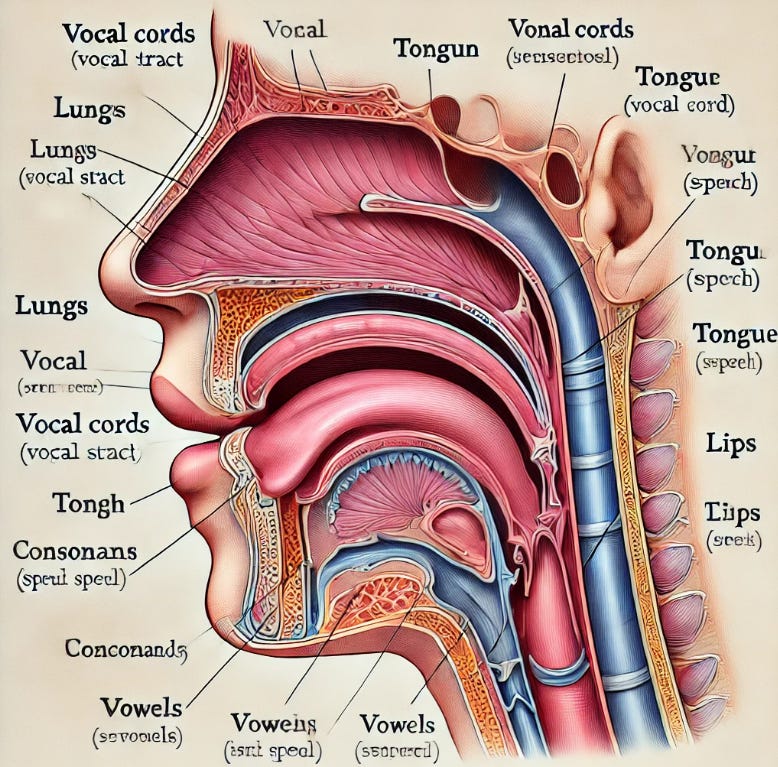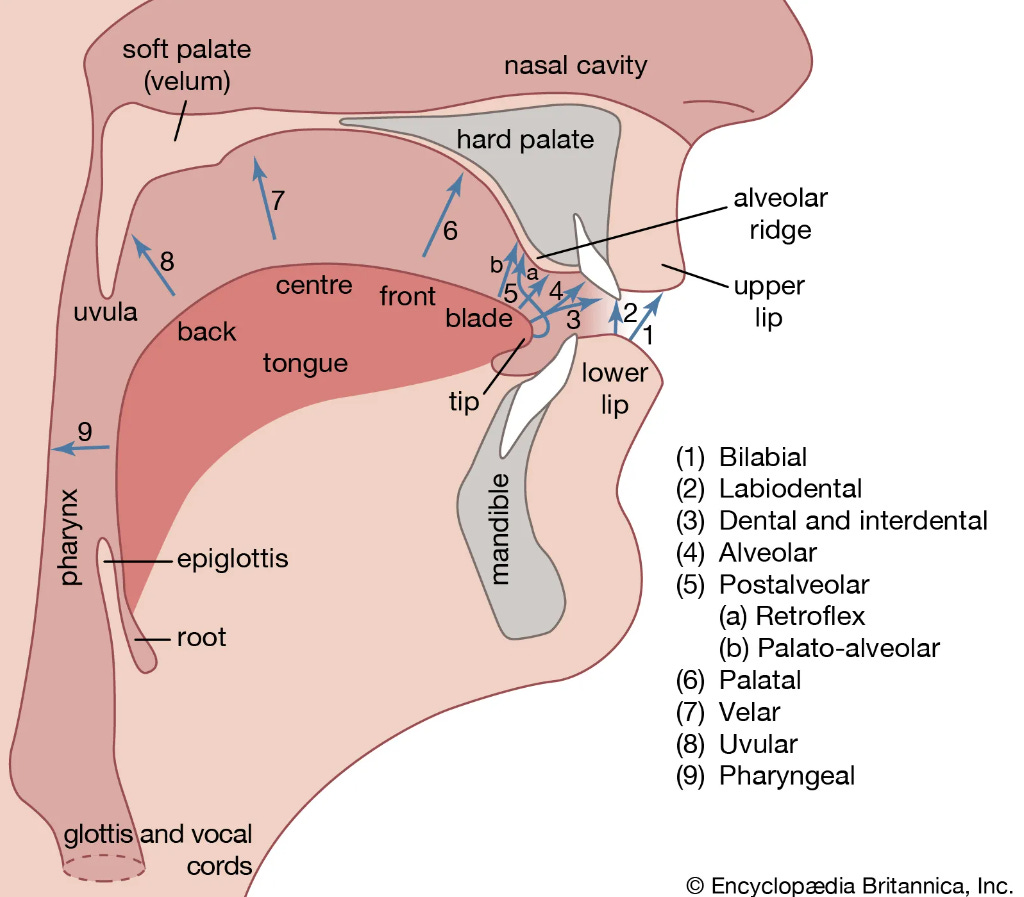The Sound of Language
Phonetics is the foundation of any study of language. It deals with the physical sounds that humans produce when they speak. Understanding these sounds is key to learning how languages work, how we communicate, and even how different accents arise. In this post, I want to show you what phonetics is, break it down into its three main branches, and explain why it matters to anyone curious about language.
What Is Phonetics?
Phonetics is the branch of linguistics that studies the physical properties of speech sounds. While language can be studied in terms of meaning (semantics) or structure (syntax), phonetics looks at language in terms of sound: the vibrations in the air produced by our vocal apparatus that allow us to communicate.
Phonetics is not about understanding what words mean or how sentences are formed, but about how we create, transmit, and perceive the sounds that make up language. Whether you are listening to someone speak English, French, or Swahili, phonetics gives us the tools to describe and analyse how their speech is produced and understood.
Why Is Phonetics Important?
Phonetics allows us to:
Describe and compare sounds: We can analyse sounds in any language, even ones we do not speak, using a universal set of symbols (the International Phonetic Alphabet, or IPA).
Understand speech disorders: Phonetics is crucial for speech therapy, as it helps us diagnose and treat issues with speech production.
Improve language teaching: Understanding phonetics can help learners of new languages improve their pronunciation.
Develop technology: Phonetics plays a role in technologies like speech recognition software (e.g., Siri or Alexa), language translation, and speech synthesis.
The Three Types of Phonetics
Phonetics can be broken down into three key subfields, each dealing with a different aspect of how we produce, hear, and analyse speech sounds. These are articulatory phonetics, acoustic phonetics, and auditory phonetics. Let us look at each one in detail.
1. Articulatory Phonetics: How Sounds Are Produced
Articulatory phonetics is concerned with how humans physically produce speech sounds. It focuses on the movement and positioning of the different parts of the vocal tract, including the tongue, lips, and vocal cords.
Definition: Articulatory phonetics studies the organs of speech and their role in creating specific sounds.
Purpose: Its primary goal is to describe the way we produce consonants, vowels, and other speech sounds in terms of the movement of the tongue, lips, and airflow.
How It Works:
Articulatory phonetics divides speech sounds based on how and where they are produced in the vocal tract:
Consonants are produced by obstructing airflow at various points, such as with the lips (e.g., /p/, /b/), teeth (e.g., /f/, /v/), or the back of the mouth (e.g., /k/, /g/).
Vowels are produced by allowing air to flow freely through the mouth while shaping the sound with the tongue and lips.
Examples:
Bilabial sounds (e.g., /p/, /b/): Both lips come together to obstruct airflow.
Alveolar sounds (e.g., /t/, /d/): The tongue touches the alveolar ridge just behind the teeth.
Velar sounds (e.g., /k/, /g/): The back of the tongue touches the soft part of the roof of the mouth (velum).
Refer to the vocal tract diagram above to see where different sounds are articulated.
2. Acoustic Phonetics: The Science of Sound Waves
Acoustic phonetics focuses on the physical properties of the sound waves produced when we speak. It looks at characteristics like frequency (pitch), amplitude (loudness), and duration (length of the sound).
Definition: Acoustic phonetics studies the sound waves that are generated by the human vocal apparatus when we speak.
Purpose: Its goal is to measure and analyse the properties of these sound waves to understand how they relate to the sounds we perceive.
How It Works:
Acoustic phonetics uses tools like spectrograms to visualise sound waves and analyse their patterns. Different speech sounds have unique acoustic signatures, which allows linguists to study the subtle differences between them.
For example:
Pitch: How high or low a sound is. Vowels tend to have higher pitches, while consonants, especially stops like /p/ or /t/, are lower.
Loudness: Some sounds are naturally louder than others (e.g., vowels tend to be louder than consonants).
Duration: Long vowels or consonants have a longer duration than their short counterparts.
Practical Applications:
Acoustic phonetics is essential in speech recognition software. Computers use acoustic data to identify and transcribe speech.
It is also used in forensic linguistics to analyse voice recordings in criminal investigations.
Example:
If you have ever used a spectrogram to analyse your voice, you have engaged with acoustic phonetics. The spectrogram shows you the different frequencies and intensities of the sounds you produce.
3. Auditory Phonetics: How We Perceive Sounds
Auditory phonetics deals with how we hear and process speech sounds. It focuses on the listener’s role in interpreting sound waves and how the brain decodes the information to make sense of speech.
Definition: Auditory phonetics studies the way the human ear and brain perceive speech sounds.
Purpose: It aims to understand the processes by which the brain recognises, differentiates, and interprets sounds.
How It Works:
The ear captures sound waves, and the brain processes them into meaningful units like words and sentences. Auditory phonetics investigates issues such as:
Speech perception: How do we distinguish between similar sounds, like /b/ and /p/?
Auditory processing: How does the brain process complex streams of speech in noisy environments?
Practical Applications:
Speech therapy: Understanding auditory phonetics can help diagnose and treat hearing or speech perception issues.
Hearing aids and cochlear implants: Auditory phonetics plays a role in the development of technologies to assist people with hearing impairments.
Example:
Consider how non-native speakers of a language often struggle to distinguish between sounds that are not present in their native language. For example, native Japanese speakers may find it difficult to distinguish between the English /r/ and /l/ sounds because these are not distinguished in Japanese. Auditory phonetics helps explain why this happens.
Why These Types of Phonetics Matter
Together, these three branches of phonetics give us a complete picture of how we produce, transmit, and understand speech. By studying the articulatory, acoustic, and auditory aspects of speech, linguists can understand:
Why accents differ.
How different languages use sound in unique ways.
How humans perceive speech despite differences in speed, clarity, or environment.
Phonetics has applications in many areas, from teaching foreign languages to developing AI that can understand and produce speech. Whether you are learning a new language, studying speech disorders, or developing technology, phonetics gives you the tools to analyse and understand speech at a deep level.
The International Phonetic Alphabet (IPA)
A key tool in the study of phonetics is the International Phonetic Alphabet (IPA), a system that assigns a unique symbol to every possible speech sound. This allows linguists to represent the sounds of any language without relying on the specific spelling systems of those languages.
For example:
/p/ represents the first consonnant sound in “pat”.
/i/ represents the vowel sound in “see”.
©Antoine Decressac — 2024/2025
Next: Phonetics: More Than Just Sounds — It’s About Who We Are
Further Reading and Resource:
To explore phonetics in greater depth, here are two great resources to get you started: As an Amazon Associate, I earn from qualifying purchases
A Course in Phonetics by Peter Ladefoged (Amazon Affiliate Link) — A comprehensive introduction to phonetics, covering all the core areas of the subject.
The Sounds of Language by Elizabeth Zsiga (Amazon Affiliate Link) — A user-friendly guide to the sounds of language, aimed at beginners.
International Phonetic Alphabet: click on the phonetic symbol to hear their sounds







